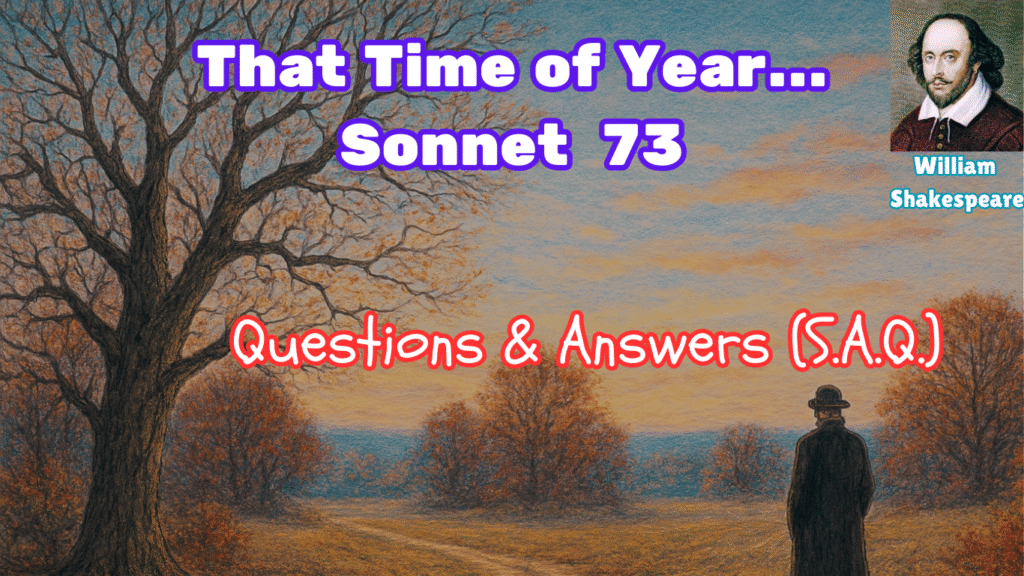
1) What time of the year is suggested in Sony 73? Why
Ans. The time of the year suggested in the poem is late autumn, when leaves turn yellow, trees become bare, and birds stop singing.
William Shakespeare uses autumn as a metaphor for old age. As autumn comes before winter, old age comes before death.
2) Why does the poet compare himself to the ‘time of year’?
Ans. The poet compares himself to the ‘time of year’ e.g. late autumn to show his listeners to notice his aging that he is in the final stage of the year.
3) How does Shakespeare use the imagery of Autumn to describe ageing in the Sonnet?
Ans. Shakespeare uses the imagery of autumn to show that his life is declining. He is approaching old age and death. He compares himself to a tree in late autumn. The leaves are “yellow or none, or few”. The branches are ‘bare ruined choirs”.
4) “thou mayst in me behold” – What will the listener behold?
Ans. The listener will behold the poet’s ageing and the signs of the final stage of his life.
5)”when yellow leaves, or none, or few, do hang” – what do the yellow leaves symbolise in this line?
Ans. The yellow leaves symbolise the poet’s declining energy, ageing and the last stage of life. They also symbolise the end of the year, as the features mentioned in the line come in the month of autumn.
6) Explain the metaphor of the line “bare ruin’d choirs”.
Ans. ‘Bare ruined choirs’ is a picture of a ruined and deserted church where there are no choirs. The image is a metaphor indirectly comparing the empty branches of a tree and the singing of the birds no longer being heard.
7) What are the leafless branches of the tree compared with those in Sonnet 73?
Ans. See the answer to question number 6.
8) How does the image of ‘bare ruined choirs’ enhance the theme of decay?
Ans. The image of ‘bare ruined choirs’ enhances the theme of decay by comparing the leafless branches of autumn. The phrase ‘bared ruined choirs’ suggests emptiness, destruction, degeneration and silence.
9) “bare ruined choirs where late the sweet birds Sang”. What does the word ‘sang’ signify?
Ans. The word ‘Sang’ signifies the poet’s youthful days when he was melodious, liveliness and filled with energy and happiness.
10) Why does the poet compare his life to ‘the Twilight of such day’?
Ans. The poet compares his life to ‘the Twilight of such day’ to suggest that he is in the last phase of his life. Twilight means fading brightness and coming close to the darkness. So it symbolises the poet’s declining strength, and life is slipping away.
11) “after sunset fadeth in the West”. – What does the line signify?
Ans. The line suggests the inevitable end of life. After the sunset, the light fades and the darkness follows. In the same way, the poet’s life is coming to an end, losing all strength.
12) “which by and by black night doth take away”. What does the black night refer to in this line?
Ans. The black night refers to the inevitable end of life. As the night comes gradually, replacing the light, death is certain, taking away life.
13) Explain the metaphor of ‘death’s second self’.
Ans. ‘death’s second self’ is referred to sleep or night, and they are similar to death or nearness to death. The image compares the poet’s ageing and closeness to death.
14) How is the night portrait as a symbol in the Sonnet?
Ans. In the Sonnet, the night is portrayed as a symbol of death because it represents the end of the day, silence and darkness. night comes after the ‘sunset fadeth’ as death comes after the fading of life.
15) ‘that seals up all in rest’ what seals up all in rest?
Ans. ‘Death’s second self, that is sleep, a smaller version of death, seals up all in rest.
16) why does the poet compare himself to ‘the glowing of such fire’?
Ans. The poet compares his life to a dying fire that is burning out slowly. ‘The glowing such fire’ indicates that the poet’s life old age and his gradual progress towards the end.
17) what does the ‘ashes’ symbolise in the third quatrain?
Ans. After the fire is burnt down, the ashes are left. In the same way, the poet’s youth, strength, and aspirations have gone, leaving only his frail body. Thus, the ‘ashes’ symbolise remains of youth, lost strength and lost passion.
18) Explain the line ‘As the death-bed where on it must expire’
Ans. the line expresses that the poet’s life is about to finish. His mortal body will die and burnout completely.
19) “Consum’d with that which it was nourish’d by.” – what does the poet mean by this line?
Ans. By this line, the poet means that life is ended by time, but once time nourished it. Just as the fuel that strengthens the fire later it turns into ashes.
20) How does the couplet reflect the power of love in the face of ageing?
Ans. The concluding couplet conveys that true love becomes stronger in the face of ageing and death. When the poet’s beloved will understand that he will not live longer, their love will be more intense. they will value the remaining time together. The awareness of loss makes their love deep.